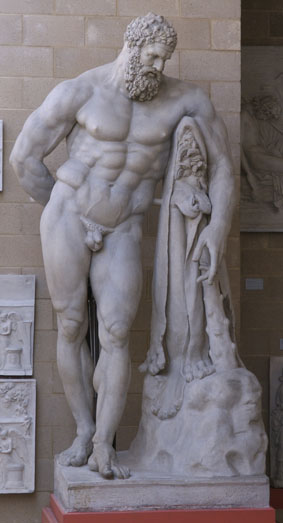
The Farnese Hercules shows the hero resting after stealing the apples of the Hesperides which he holds behind his back. Made for the massive Baths of Caracalla, he is one of the few pieces in the gallery to be signed by the artist: the Greek letters on the base tell us that the Athenian sculptor Glykon made him — presumably when the baths were built at the start of the third century CE.
After its rediscovery in the sixteenth century, the statue entered the collection of Cardinal Alessandro Farnese, from where he gets his name. The existence of other similar sculptures, large and small, show that Glykon based his Hercules on a famous model, usually attributed to the court artist of Alexander the Great, Lysippos
Naples, National Museum 280
Transferred from the Fitzwilliam Museum in 1884
Lippold: Griechische Plastik, 281 (n.8), pl. 101.1
Walston: Catalogue of Casts in the Museum of Classical Archaeology (1889), 103, no.552
Richter: Sculpture & Sculptors of the Greeks (1950), 289-, fig.749
Richter: Three Critical Periods in Greek Sculpture, 21, fig.34
Reporter: 19 June 1885, 894, no.492
Pollitt: Art in the Hellenistic Age, 50, pl. 41
Inscription: IGUR IV, 1556
Glykon of Athens made me
Found in the Baths of Caracalla, Rome, in 1540
